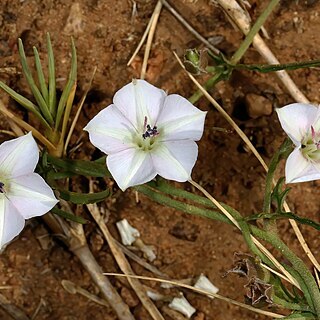An exceedingly variable perennial; stems prostrate or twining, hairy, radiating for up to 0.6 m. from a woody rootstock.. Leaf-blade oblong, triangular-ovate to linear, 2.5–7 cm. long, 0.6–2.6 cm. wide, acute at the apex, sagittate at the base, with the lobes often bifid, entire, obscurely crenate or deeply laciniate, pubescent or glabrescent, often villous when young; petiole up to 13 mm. long.. Inflorescence hairy, 1–3(–several)-flowered; peduncle 2.4–4.5 cm. long; pedicels about 0.5 cm. long; bracts minute, linear.. Sepals orbicular, ovate or elliptic, 5–9 mm. long, 2.5–4 mm. wide, obtuse, the outer longer or narrower particularly in fruit, or sepals subequal, hairy.. Corolla white, sometimes with pink or purple-red centre or pink with a purple centre, 8–20 mm. long (larger in some South African varieties).. Capsule globose, 6–7 mm. long.. Seeds brown or black, scabridulous, 3.5 × 2.5 mm.
Variable perennial with long taproot and annual stems. Stems branched from base, prostrate, up to 600 mm long. Leaves entire, variable, ± hairy, up to 60 mm long, linear to hastate-sagittate, often with bifid basal lobes; petioles very short. Peduncles 1-few-flowered, up to 45 mm long; bracteoles small; pedicels up to 30 mm long. Calyx hairy; sepals 5-9 mm long. Corolla funnel-shaped, white to mauve-pink, sometimes with darker centre. Flowering time Sept.-May. Fruit a subglobose capsule, 6-7 mm long. Seeds 4, dark brown or black, 3.5 mm long.
Perennial herb. Stems procumbent or twining, usually hairy. Leaves often folded and falcate; blade linear, > 25 mm long, base sagittate, apex obtuse, margins entire, pubescence varies from densely hairy to nearly glabrous. Flowers: usually with 1-flowered peduncles; peduncle up to 45 mm long; calyx lobes narrowly ovate to orbicular, apices acute to obtuse; corolla 8-15 mm long, lobes rounded to obtuse, white or sometimes with pink or purple-red centre or pink with purple centre; Sep.-Mar. Fruit a subglobose, glabrous capsule, 6-7 mm long.
Perennial herb, glabrous to hairy with long, thin taproot and annual, usually prostrate stems, up to 2 m long. Leaves very variable, linear to hastate-sagittate or oblong, basal lobes often bifid, up to 60 mm long. Flowers 1-few in leaf axils, sepals usually hairy, 5-9 mm long, corolla funnel-shaped, 8-25 mm long, white to mauve-pink, centre sometimes darker, midpetaline areas hairy near tips.
A herb. It lies along the ground and can be a scrambler. It has a taproot and can keep growing from year to year. It puts up annual shoots. It can grow 2 m high. The leaves are alternate and vary in shape and size. They can have 2-5 lobes. The flowers are small and up to 2 cm across. They are white to pale pink. They usually occur singly on long stalks in the axils of the leaves.
Leaf lamina very variable, oblong, triangular-ovate to linear 2·5–7 × 0·6–3 cm., acute at the apex, sagittate at the base, with lobes often bifid, entire, obscurely crenate or deeply laciniate, pubescent or glabrescent, often villous when young, petiole up to 15 mm. long, usually very short and often hairy.
Prostrate or twining perennial herb. Leaf lamina oblong, triangular-ovate to linear, sagittate at base. Inflorescence 1-3(-several)-flowered; peduncle up to 45 mm long. Corolla 8-15 mm long. Flowers white or sometimes with pink or purple-red centre or pink with purple centre.
Sepals varying from lanceolate to circular, ovate or elliptic, up to 9 mm. long, acute to obtuse, sometimes mucronate or ciliate, the outer longer or narrower particularly in fruit, or sepals subequal, hairy to glabrous.
Inflorescence 1–3-(several) flowered; peduncle up to 4.5 cm. long, usually terete, slender, often hairy; pedicels about 5 mm. long; bracts small, linear.
Corolla white or sometimes with pink or purple-red centre or pink with a purple centre, 8–15 mm. long, midpetaline areas hairy near the apices.
Glabrescent, perennial climber to 2 m. Leaves narrowly hastate. Flowers white or pink, sepals 5-6 mm long, acute, corolla 7-10 mm long.
Stems prostrate or twining, hairy, radiating for up to 0·6 m. from a woody rootstock.
Seeds usually 4, dark brown or black, scabridulous more or less glabrous when ripe.
An extremely variable perennial.
Capsule subglobose, glabrous.

